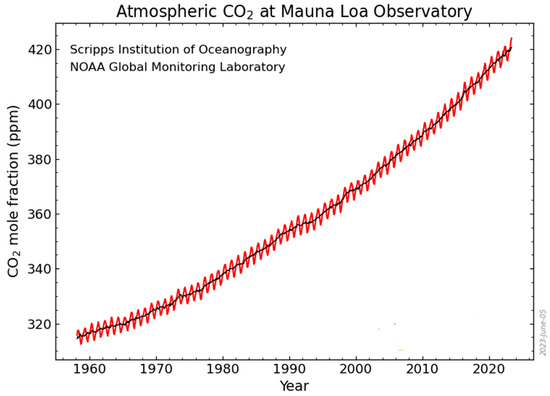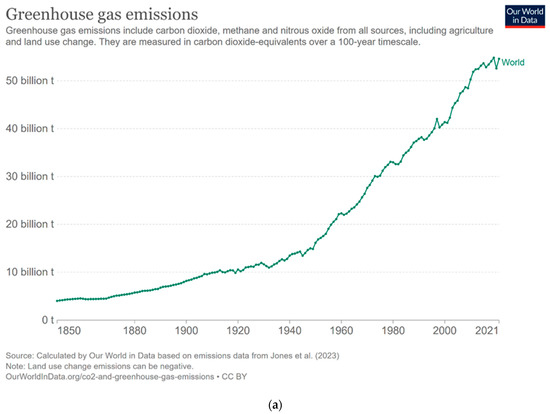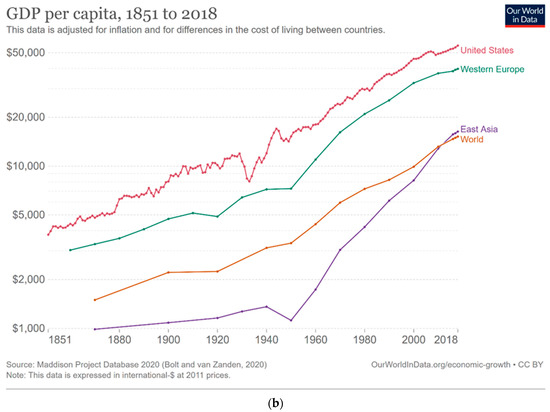The multiple threats due to impacts of ACC are now thought to constitute a global emergency
[1], with potentially catastrophic consequences for humanity
[2]. Notwithstanding decades of international research, political debate and increasingly ominous scientific warnings since the first IPCC assessment in 1990, the failure of mitigation through carbon emissions reduction is depressingly clear. In fact, the global increase in CO
2 emissions has been relentless, with emissions now 60% higher than they were in 1990
[3]. Monthly mean carbon dioxide measured at the Mauna Loa Observatory, Hawaii, constitutes the longest record of direct measurements of CO
2 in the atmosphere (see
Figure 1). This monitoring program was started by C. David Keeling of the Scripps Institution of Oceanography in March 1958 at a facility of the National Oceanic and Atmospheric Administration
[4]. Current CO
2 concentration (April 2023) at Mauna Loa is 423 ppm, which is an increase of about 108 ppm (or 35%) since the start of the monitoring program. The current emissions trajectory puts the world on track for a temperature rise of between 2.1 °C and 3.9 °C by the end of this century
[5], with even the lower temperature bound implying severe disruption to many of the Earth’s systems.
2. Mitigation Failure
Global carbon emissions increased rapidly from the mid-20th century (see
Figure 2a), coinciding with a sharp upturn in a multitude of global socio-economic indicators at that time (See
Figure 2b), a phenomenon termed the ‘Great Acceleration’
[21]. It is important to note that per capita GDP has increased faster than global population, with the “average person” in the world now being 4.4 times richer than in 1950, during which time the world population has increased 3-fold, from around 2.5 billion to almost 7.5 billion today
[22]. It is pertinent to reflect on what the number of impoverished people would have been without this increase in GDP, largely enabled by the combustion of fossil fuels. This highlights the ethical and social justice dimensions of attempts at emissions reduction, where the remaining carbon budget (to avoid catastrophic CC) needs to be allocated amongst countries in a fashion that is deemed fair to all parties (see Zhou and Wang
[23] and Williges et al.
[24] for reviews of this contentious field).
Various multi-faceted reasons for our collective failure to bend the global emissions curve have been identified
[3]. These include, inter alia, economic, geo-political, psychological and sociological factors, all combining to create an almost immutable status quo. In addition, the last three decades have seen a concerted effort to either deny the reality of CC
[28][29] or, through the use of more nuanced arguments, to seek to delay climate action
[30]. These denialist strategies have been successful, as shown by recent analyses of public opinion in the USA, where public understanding of global warming is improving but remains low and perceived personal risk is still very low
[31]. In the highly polarized and politicized USA population, the expression of skeptical opinions appears to have more influence on public perceptions than factual science
[32]. Likewise, studies of public opinion in Europe suggest that climate change experiences (e.g., extreme weather events) can increase support for climate action, but only under favorable economic conditions
[33]. A similar relationship was found in Australia, where climate change skepticism was shown to be negatively associated with the annual global temperatures the previous year
[34].
Some authors point to a breakdown of the science–society contract, referring to the tragedy of climate change science—namely, that despite compelling evidence and fresh warnings issued ever more frequently, greenhouse gas (GHG) emissions and other indicators of adverse climate impacts have risen steadily. This lack of societal action has led some to suggest a moratorium on further CC research
[35]. The only momentary slowing of emissions occurred during the 2008–09 GFC, with a rapid rebound in subsequent years
[36], underscoring the tight coupling of global economic growth and fossil fuel usage. This multi-faceted complexity emphasizes the “wicked” nature of the CC problem which underpins the difficulty in addressing the climate change threat through efforts at societal decarbonization. As first discussed by Rittel and Webber
[37], wicked problems always occur in a social context—the wickedness of the problem reflects the diversity among the stakeholders affected by the problem. In the context of climate change, all of us are arguably stakeholders, which underscores both the complexity of the problem and the difficulty of reaching international consensus on ways forward.
Carbon capture and storage (CCS), once thought to be a central technology to offset present and future GHG emissions while continuing societal use of fossil fuels, has proved to be expensive and difficult to deploy at the required rate due to the limited availability of storage sites
[38][39]. At current rates of deployment, CO
2 storage capacity by 2050 is projected to be around 700 million tons per year, just 10% of what is required
[40]. Oreskes
[41] describes CCS as a technology that does not yet exist—in other words, despite many attempts, it has not been shown to be a way to store carbon in the ground safely, permanently and affordably.
3. Calls for Transformative Change
It is evident that the rate of mitigation needs to increase and that the international community must urgently reduce GHG emissions. What is also clear is that this implies nothing less than wholesale societal changes, without which CC impacts will continue and likely accelerate. This will only happen through deep changes to our energy, industry, transport, food and financial systems. In the context of widespread global environmental degradation (of which CC is only one, albeit important, part), Diaz et al.
[42] urge transformative change that tackles the root causes: the interconnected economic, sociocultural, demographic, political, institutional and technological indirect drivers behind the direct drivers. A call for just such a societal transformation was made in the papal encyclical “Laudato Si” by Pope Francis
[43]. More recently, faith leaders representing the world’s major religions joined scientists at the Vatican to call on the international community to raise their ambition and step up their climate action ahead of the UN Climate Change Conference COP26 in November 2021 in Glasgow. The faith leaders’ appeal stated: “We must address these challenges using the knowledge of science and the wisdom of religion. We must think long-term for the sake of the whole of humanity. Now is the time to take transformative action as a common response”.
4. Nonlinearity in the Climate System
The nonlinearity of the climate has been recognized for quite some time
[44] and may lead to abrupt and dangerous perturbations to the climate
[45]. Nonlinear dynamical systems are characterized by several important differences from linear systems. These differences include:
- -
-
The possibility of the system undergoing sharp transitions, even in the presence of steady forcing;
- -
-
A small change in some parameters can cause great qualitative differences in the resulting behavior (e.g., chaos);
- -
-
The response of a nonlinear system to oscillatory external forcing usually exhibits frequencies not present in the external forcing.
Nonlinear dynamical systems are challenging to model and can harbor surprises or manifest periods of abrupt change (or even persistent catastrophic shifts), notwithstanding only gradual change in external forcings, e.g., increasing GHG emissions
[46]. Abrupt change in the climate system has been identified in the paleoclimatic ice core record even during the otherwise relatively stable Holocene epoch
[47][48]. Indeed, various potential “climate tipping points” have been identified in the Earth’s climate system
[49]. Examples of these tipping points include, inter alia, triggering polar ice sheet collapses, polar permafrost thawing, monsoon disruptions and forest and coral reef diebacks. If triggered, these could cause rapid, and perhaps irreversible, planetary change
[50]. Although the timing of such possible changes is uncertain, their occurrence will likely be a function of the degree of warming
[51]. Armstrong Mackay et al.
[52] note that even a global warming of 1 °C, a threshold that we already have passed, puts us at risk by triggering some tipping points. Limiting global warming to 1.5–2 °C—as agreed upon in the Paris Accord—could still mean exceeding the best estimates for several tipping points, causing the loss of mountain glaciers and the disruption of key ocean currents. This finding underscores the urgency of limiting additional warming as much as possible.
5. Enhancing Natural Carbon Sinks
Agricultural land use practices have historically been a major contributor to GHG emissions and are still responsible for up to a third of total anthropogenic GHG emissions
[53]. Poor land management has caused between 1 and 6 billion hectares of global soils to be considered degraded to varying degrees
[54], having lost much of their soil organic carbon (SOC) through the historical expansion of agriculture
[55]. The main land-based mechanisms to enhance emissions sinks (so-called ‘negative emissions technologies’) are through improving the SOC of degraded agricultural lands and through afforestation or reforestation. For context, it is useful to note that, during the last decade (2011–2020), the net global increase in anthropogenic CO
2 emissions, after accounting for ocean and land sinks, was 4.9 GtC yr
−1 [56]. If land management practices are improved, it is estimated that sequestering organic carbon in soil could potentially remove up to 1.54 GtC yr
−1 from the atmosphere, while afforestation and reforestation could remove up to 0.98 GtC yr
−1 [57]. These approaches would provide significant environmental co-benefits, such as improving soil health and food security, apart from addressing ACC
[58]. However, as noted above, the period left to implement change at the scale required is short, and improved land management practices need to be rapidly scaled up and implemented to contribute effectively to climate change mitigation
[59][60]. Unfortunately, accurate estimates of land use emissions are still being assessed, and uncertainties in land use emissions are very high
[61].



